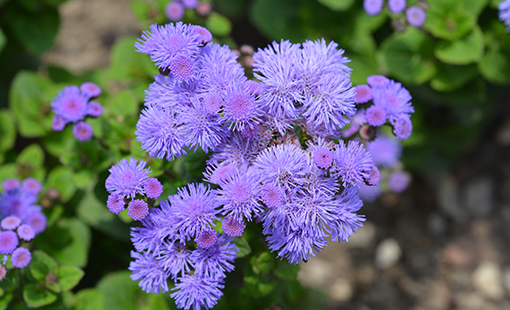
Growing Ageratum
Ageratum, also known as floss flower, is a member of the Aster family, includes more than 40 annual and perennial plant species native to Central America and Mexico, but for North American gardeners, the name ageratum generally refers to Ageratum houstonianum.
This annual plant is useful in flower beds for the large masses of bright purplish-blue flowers that bloom reliably from late spring until the first frosts of fall. At one time, only very low varieties were available, making this primarily an edging plant, but now there are now more upright varieties available, growing as much as 30 inches tall, making it also useful for the middle of the flower garden. Few other plants offer the long bloom period and the unique blue color of ageratum, though cultivars in different colors are also available.
Ageratum is normally planted from nursery bedding packs in the spring after all danger of frost has passed and the ground is warm. It can also be grown from seeds started indoors; the plant will flower about 60 to 70 days after the seeds sprout.
Care
Ageratum is a useful plant for lending long-lasting color in the mixed flower bed. Low-growing varieties are often used as edging plants or in rock gardens. Taller plants are a good addition to cutting gardens. Ageratum will do well in sunny locations planted in moist but well-drained soil that has been amended with compost or peat moss. Space shorter varieties about 6 inches apart, taller varieties about 12 inches apart.
As they become established, ageratums need to be kept moist. Once established, they will tolerate periods of dryness but will perform best if regularly watered. Covering the soil with mulch will help preserve soil moisture.
Light
In cold climates, give floss flower full sun.
Soil
Plant ageratum in well-drained but moist soil that has been amended with compost. It is not fussy about soil pH, which increases this annual’s versatility.
Water
Keep plants constantly moist as they are getting established. After this, about 1 inch of water per week from rainfall and/or irrigation will keep them healthy, but don’t worry about short periods of drought, especially if the soil is well-mulched. Water through ground-level soaking rather than overhead spraying.
Temperature & Humidity
These plants are native to Mexico and Central America and will do best in warm conditions. Avoid the temptation to plant them too early in the season, as they may remain stunted for the entire growing season. Humid conditions may make ageratums susceptible to fungal problems; make sure the plants have good air circulation.
Fertilizer
Floss Flowers don’t require a lot of feeding when planted in good, rich soil, but if the leaves begin to turn yellow, it’s a sign they need nutrients. Granular slow-release balanced fertilizer mixed into the soil around the plants should return them to good health and profuse blooming.
Varieties
There are many varieties of ageratum, with new cultivars regularly introduced. Consider these favorites:
- ‘Blue Horizon’ is a taller blue variety, growing to 2 feet.
- ‘Hawaiian Royal’ is a traditional compact series that is known for having genuine blue flowers.
- ‘Red Top’ is a tall-growing variety with burgundy flowers.
- ‘Southern Cross’ is a compact form of ageratum with bi-colored flowers.
- ‘Blue Danube‘ is an early blooming, 6- to 7-inch plant with icy blue-purple flowers.
- ‘Red Flint’ is an unusual red variety that grows 24 inches tall.
- ‘Dondo White’ is a white-flowering variety that grows to 24 inches.
Pruning
When the plants are young, pinching back the growing tips will cause the plants to spread and fill out. Though not essential, deadheading the spent flowers will stimulate continued growth and blooms. These plants will die back at the first hint of frost, at which time they should be pulled from the garden.
Potting & Repotting
Floss flower can make a good plant to include in mixed patio containers, hanging baskets, or window boxes. It will do well in any well-draining commercial potting mix.
Common Pests & Diseases
Powdery mildew, a soil-borne fungus, can affect ageratums. Prevent the spores from splashing up on the plants by watering at ground level rather than spraying from overhead.
Spider mites can be a problem in hot, dry weather. Misting regularly can prevent these infestations. Damaged plants can be cut back and will usually sprout again.
Information courtesy of TheSpruce.com

 Adams Fairacre Farms
Adams Fairacre Farms